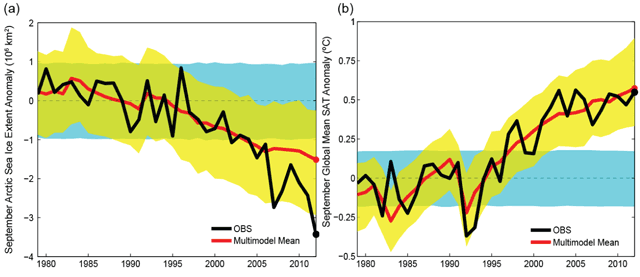May 23rd, 2014
Key Findings
- Comparisons between observations and 19 models reveal that the 2012 anomaly and the rapid decline trend in the early 21st century of the observed summer Arctic sea ice extent are very rare occurrences in the context of these models and their responses to anthropogenic and natural forcing combined.
- The observed extreme low summer Arctic sea ice extent anomaly is detectable compared with simulated inter-annual variability but significantly stronger than the response in the models to anthropogenic and natural forcing combined.
- For the period 2001-2012, the observed September Arctic sea ice extent decline trend is so rapid that it lies outside of the 5th to 95th percentile range of the multi-model distribution of forced responses.
- The observed September global mean warming trend for the same period is so small that it is not detectable, although it is not inconsistent with the CMIP5 models’ All-forcing runs.
Rong Zhang and Thomas R. Knutson. Explaining Extreme Events of 2012 from a Climate Perspective.
Summary
The rapid change in summer Arctic sea ice could have significant large scale climatic, ecological, and economic impacts. Understanding the mechanisms for the recent rapid decline in summer Arctic sea ice will help to predict future changes in summer Arctic sea ice and associated climatic, ecological, and economic impacts.
In this study, we focus on the observed September Arctic sea ice extent anomaly in 2012 and the trend in recent years, both in comparison with model-simulated internal variability and with model simulations forced by anthropogenic and natural forcings combined. We use multiple Coupled Model Intercomparison Project Phase 5 (CMIP5) model simulations to explore whether the observed summer Arctic sea ice extent decline can be explained by the response in the models to anthropogenic and natural forcing combined, and how it relates, statistically, to the observed warming in the global mean surface air temperature (SAT).
Comparisons between observations and 19 models reveal that the 2012 anomaly and the rapid decline trend in the early 21st century of the observed summer Arctic sea ice extent are very rare occurrences in the context of these models and their responses to anthropogenic and natural forcing combined. Several possible reasons are discussed for the discrepancy between observations and multi-model simulations in the early 21st century.



